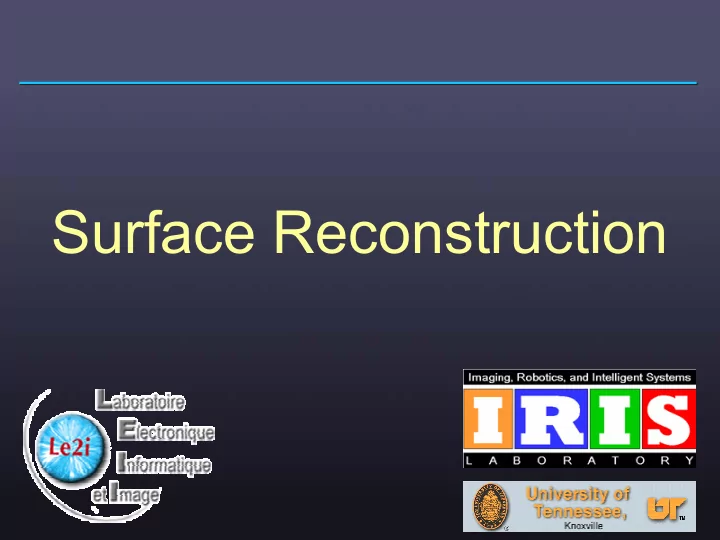

Surface Reconstruction
Approach • Overview of important methods • Properties needed • Possible solution – Method – Current work – Next Steps • Conclusions and Discussion
Overview of different methods Voronoi diagrams and Delaunay triangulation / tetrahedrization Voronoi cells creation Links creation Triangles removal Point set p Fig a Fig b Fig c Fig d
Delaunay Triangulation algorithms Complexity = O(n 2 ) in 3D Can be decreased to O(n) with uniform sampling and other assumptions Different algorithms : •Divide and conquer •Convex hull sculpting •Alpha shapes •Incremental construction
Surface Deformation • Energy minimization process • Start from an initial rough shape • Deform it until a local minimum is reached
Example The liver template (Johan Montagnat, Inria) Evolution of a model (on one slice of the whole 3D image). •Rough initialization •Successive deformations •Energy deformation is functions of liver's contour points
Properties + Fast methods + initial guess easy to find - Closed surface - Local minimum - Importance of initial guess
Implicit functions • Concept : surface = zeroes of a function – Iso-surface – Space partition (inside/outside/on the object) • Lots of possible (and famous) solutions – Hoppe, Amenta … F(X) = 0 Ex : equation of sphere F(X) < 0 x 2 + y 2 + z 2 – 1 = 0 F(X)>0
Example of skeleton extraction `frame" over which the ``meat" of the shape hangs locus of the centers of all tangent discs contained in the shape.
Polygonization • Marching cubes (or triangles) Images from Lakshman Prasad newsletter
Properties + Important Data size reduction + Primitive + Adaptable polygonization + Objects can have holes + n-dimension function - Approximating - Important computation time : Recent improvement (RBF) decreased complexity to O(n 2 ) -- Closed surface (c’est pas tout a fait vrai mais)
Patches Numerous approaches : Idea : locally find the “best fitting” surface patch to reconstruct the surface Least square data-fitting • Spatial Recursive subdivision and curve fitting • Subdivide the space to reduce the number of points. • Surface fitting faster Idea : subdivide the space to fit lower degree splines.
Recursive spatial subdivision Images from Benjamin Gregorski, Bernd Hamann, and Kenneth I. Joy
Patch joining Images from Benjamin Gregorski, Bernd Hamann, and Kenneth I. Joy
Properties? Scheme type Topological Robustness Primitive extraction Main drawback restrictions to noise delaunay interpolating None Weak No No primitive extraction deformation approximating Simple Strong Yes Very simple objects (no objects holes) implicit Approximating Closed Strong Yes No boundary objects, no (can be both) boundaries patches both None Adjustable Yes Continuity between patches
Goals • Speed and important data size • Primitive extraction (higher abstraction) • General approach • Manage boundaries Hierarchical Patch Approach
Possible Solution Principal direction for “Iso-value” lines each point Minimizing curvature variation Local energy extrema Image from Meyer and Desbrun 2002
Hierarchical Patch extraction Curvature Local curvature energy energy maxima Local curvature t energy minima 1 0 Initial function F 0 (t) t 1 0 t many parametric functions + control meshes I 1 I 2
Result? Isolated point 0A Isolated point 1A Patch 1-A Patch 0-0 Isolated point 1B Patch 3-A Patch 1-B Patch 2-A Patch 1-C Isolated point 3A Profile Profile reconstructed example
What Now? • Segmentation of the point cloud based on curvature – “Good” Uniform sampling – Pseudo-Uniform sampling with holes or cracks – New model with non uniform sampling
Next steps Work on surface theory • What kind of surface? • Uniform or non-uniform • Quadratic, cubic, else • How to combine them? • How to merge them? • Subdivision surfaces • R-functions
Conclusions and discussion Hierarchical patch reconstruction 1. No topological restriction (boundaries) 2. Parametric approach � adaptable meshing 3. Different levels of details 4. Size reduction
Recommend
More recommend